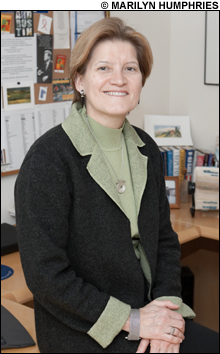 There’s no doubt that AIDS is a different disease than it was two decades ago. Rebecca Haag wants to make sure we’ll be able to say the same thing 20 years from now. As Aids Evolves from an emergency epidemic of mysterious origin into a fact of life in america, those who fight it are rethinking their strategy. Haag, who Is lauded for turning around the faltering AIDS Action Committee of Massachusetts (AAC) when she became its executive director three years ago, will now try to do the same thing nationally, as she assumes an additional — but separate — position as executive director of the Washington, DC–based AIDS Action. Last week, the Phoenix talked with Haag about how she plans to move forward.
There’s no doubt that AIDS is a different disease than it was two decades ago. Rebecca Haag wants to make sure we’ll be able to say the same thing 20 years from now. As Aids Evolves from an emergency epidemic of mysterious origin into a fact of life in america, those who fight it are rethinking their strategy. Haag, who Is lauded for turning around the faltering AIDS Action Committee of Massachusetts (AAC) when she became its executive director three years ago, will now try to do the same thing nationally, as she assumes an additional — but separate — position as executive director of the Washington, DC–based AIDS Action. Last week, the Phoenix talked with Haag about how she plans to move forward.
DEIRDRE FULTON: You’ll now be leading two organizations. What is the significance of this announcement?
REBECCA HAAG: I think that those of us at the AIDS Action Committee in Massachusetts — both the staff and the board — know that we’re doing everything we can to stop the spread of this disease in Massachusetts. But many of our challenges are also at the national level.*1 We can’t isolate ourselves and work just on Massachusetts issues. I think both boards thought that it was time for a new, innovative approach. I think we all believe that what happens in Washington, DC, must be informed by the reality of what we face all over the country.
DF: What lessons that you’ve learned at the helm of AAC Massachusetts will you bring to your work in Washington?
RH: Part of what I brought to the AAC three years ago was many years of experience in business and in management. And I think one of the things that’s happening right now in our field is that we’re having to operate on a lot less resources than we once had.*2 And this agency has experienced cuts, as have other agencies. We believe that it’s really important that we operate here as efficiently and effectively as possible. So even though we’ve lost service dollars, we’ve found other ways to preserve those services: by being better at our fundraising efforts, by being more efficient in our management.*3 So that orientation — of ensuring that we use every dollar really wisely — will be part of what I bring to AIDS Action work in Washington.
DF: What do you want to do first?
RH: One of the things we want to do at the AIDS Action Foundation in Washington is launch a 10-year planning process that would identify where we want HIV and AIDS to be 10 years from now. What are the measurable goals and outcomes that we’re looking for? For example, we’re 20 years into the disease, and there’s still no cure. If in fact we think a cure is possible, how do we get the resources aligned, from all the different sources, to make sure that happens? And in what realistic time frame?*4 What’s the level of infection in our country that’s acceptable? Would HIV become something close to syphilis, where we as a society are able to tolerate a certain level of HIV, but certainly not one at epidemic proportions?
DF: How has the disease evolved over the past two decades, and what do you think is on the horizon?
RH: Well, clearly the best news is that HIV and AIDS are no longer a death sentence for all people. In fact, with the introduction of the retroviral regime of drugs, we actually can keep many people alive. The problem with that is that many patients have severe complications from the drug, 10 percent of all new infections are drug-resistant, the virus continues to mutate, there’s still a growing number of people who are HIV-positive, and every day there’s new infections. So we clearly haven’t stopped the epidemic, or stopped the spread. But because we are at least maintaining the vast majority of those cases, people don’t see — they don’t know people who are dying from HIV. So, many people believe the crisis is over. Early on, there was lots of hope — there continues to be hope — but more and more we’re finding that we’re likely to have to live with this disease longer than we had thought. The same thing happened with cancer. Many years ago, the focus was on a cure for cancer. And more and more, there began to be an acceptance that cancer might exist in the population, but that we needed to be able to eradicate incidents of it, or at least manage it. We need to take that same framework and apply it to HIV-AIDS.
DF: How have things changed on the organizational side?